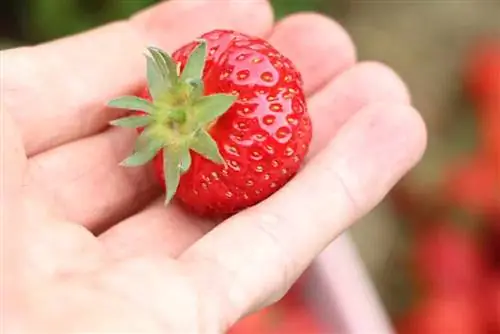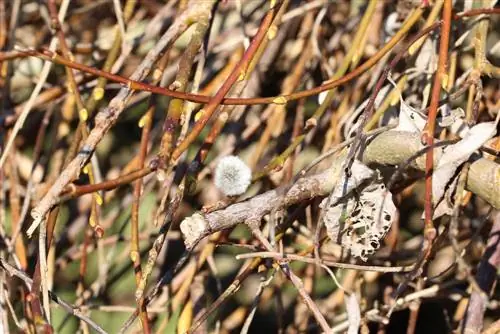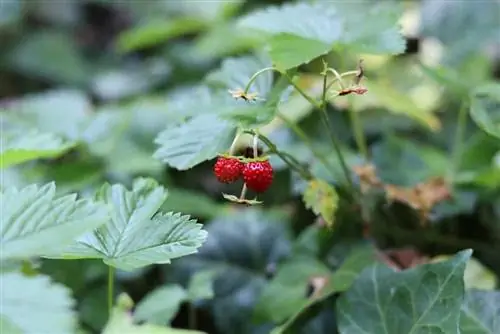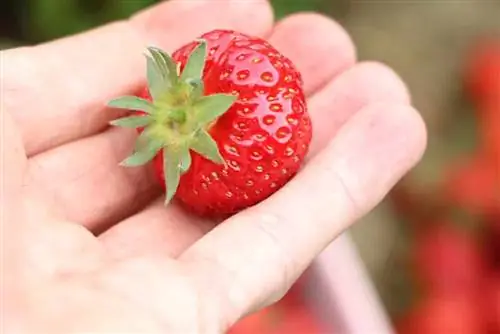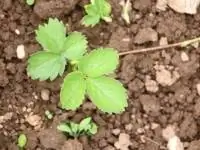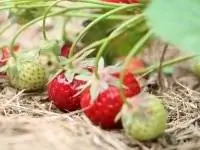- Author admin [email protected].
- Public 2023-12-17 03:39.
- Last modified 2025-01-24 12:45.
Many city dwellers are tired of the bland supermarket fruits and want to harvest them on their own balcony. The limited space available is often expanded by hanging plants or hanging plants over the balcony box. The hanging strawberry has therefore been an absolute guarantee of sales for quite a long time. Below you will find out how it can also guarantee taste for you and your family:
The mainstream hanging strawberries
The hanging strawberries have multiplied from year to year, and now you are almost overwhelmed at the beginning of the balcony season - but “grab it immediately” is usually not the best advice: the Internet carries lots of photos of hanging strawberries (on super mega mail order sites) on the screen that any Photoshop user would immediately see as being too beautiful to be real. When the hope of a rich harvest takes over, people no longer look at the variety, but home and hobby gardeners end up with offers like this:
Giant Climbing Strawberry, Strawberry Giant Red Climbing, 30 Seeds, Product Description: Giant Climbing Strawberries, sweet and delicious. That's all, you don't learn any botanical plant name, no cultivar, nothing about how the plants are raised and nothing about the trading company, which cannot be visited anywhere in real life. In the testimonials for this offer, one customer tells of many strawberry plants after weeks of waiting, another got 2 intensely yellow flowers and 0 strawberries, the third gave up disappointed - such offers can also produce plants, you just don't know for sure whether and which ones (normal strawberries bloom white).
If you want to get a delicious, bountiful harvest, you should know which strawberry to buy. If you choose a particular variety, you can later decide whether you like its fruit or whether you would prefer to try a different variety next. Aside from the untrustworthy strawberry wonders, hanging strawberries are offered that were “bred” from two different types of strawberries (the quotation marks are explained further below):
1. Monthly strawberries
The monthly strawberry is a cultivated form of our wild strawberry “Fragaria vesca”, which bears longer and significantly larger fruits. Monthly strawberries, which form particularly long runners, are among the best-known hanging strawberries, e.g. B. in the following varieties:
- Fragaria vesca var. semperflorens 'Blanc Amélioré' comes from Great Britain with particularly large white fruits
- Fragaria vesca var. semperflorens 'Gartenfreude' comes from Germany, large fruits
- Fragaria vesca var. semperflorens 'Magnum Cascade', easy to care for, harvest time June - October
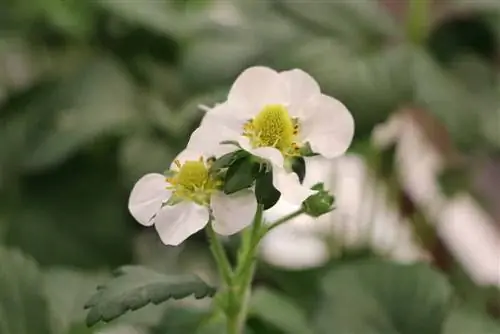
There are countless other varieties with “hanging talent” that are offered as monthly strawberries or hanging strawberries, depending on the retailer’s marketing skills. Nice fun, especially for children who can finally snack constantly (because it's he althy); However, these hanging strawberries do not produce a strawberry harvest in the true sense (for strawberries with whipped cream, cake, jam).
2. Garden strawberries
Longer-bearing trailing strawberry forms were also “bred” from our normal garden strawberries (which bear the strawberries that you also buy in the shell in the store):
- Fragaria x ananassa 'Hanging Strawberry', widely sold, but not known as an official breeding variety and thus again a kind of "surprise package" in which the exact product description and trust in the retailer are important
- Fragaria x ananassa in “Hummi varieties”
- Fragaria x ananassa 'Hummi Praline' and 'Hummi® KletterToni' (also climbing strawberry Hummi Toni) are said to be particularly good as hanging strawberries
- Fragaria x ananassa 'ELAN F1' is a younger cultivar that is also available as a climbing strawberry.
And other modern varieties, but the same applies to the ever-bearing garden strawberries as to the “hanging monthly strawberries”: It won’t be a real strawberry harvest, there’s nothing more than snacking possible.
In addition, all remontant varieties (as the ever-bearing varieties are called in technical language) officially and generally taste worse than the normal varieties of garden strawberries. The breeders and plant dealers involved in the sale of such hanging strawberries could read this in textbooks on the cultivation and marketing of strawberries (such textbooks are listed at de.wikipedia.org/wiki/Gartenerdbeere), but they obviously do not do so.
The creation of hanging strawberries
A quick look at the origins of these hanging strawberries will show you that in reality there are no hanging strawberries at all.
There are a lot of climbing or climbing plants, across a wide variety of plant families; In the strawberry family “Rosaceae” want e.g. B. Climbing roses, blackberries and raspberries high up or hanging out somewhere decoratively.
Only the strawberry is not a climbing or climbing plant, not at all and in none of the 20 or so species, which is why you will search in vain for “hanging strawberry plants” at all the dealers who are so serious about their profession that they forget, renaming their plant for marketing reasons. On the contrary, strawberry plants are quite native herbaceous plants, 30 cm high is “mighty high” by strawberry standards.
Hanging strawberries were created by cleverly reshaping vegetative reproductive organs: strawberries sprout long thread-like runners from the thick, slightly woody rootstock, which usually “conquer” the ground next to the mother plant, take root there and continue to grow as a new strawberry.
You can do something with this, a breeder thought back in the 1950s and bred an ever-bearing strawberry whose runners hardly take root, but are over two meters long. On January 11, 1956, the Spiegel reported the sensation: Adolf Horstmann, head of the Horstmann & Co. wholesale nursery from Elmshorn, Holstein had bred the “German miracle strawberry”. The word hanging strawberries does not appear once in the article. The “biggest sensation in soft fruit production”, in which “any further propagation is prosecuted”, is described by the then “Neckermann among gardeners” (large shipping department, 360 employees) as “the first ever-bearing espaliered strawberry that exists in the world”. presented. The miracle strawberry variety, named after his daughter 'Sonja Horstmann', was patented and registered as a protected trademark by the breeder, but even his best friends didn't learn the breeding secret.
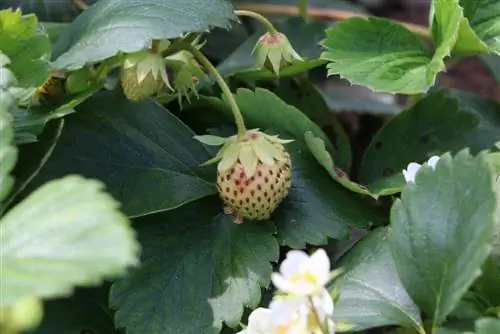
The actual breeder Reinhold Hummel, who worked on the strawberry miracle for 8 years (the article does not give a reason why he did this, at least at the end “in strict confinement” and for Horstmann), did not reveal much more, except that 'Sonja Horstmann' was created from a strawberry variety that bears twice a year and "American blood". While there are no patents to be found for 'Sonja Horstmann', at least under this name, Hummel registered the new strawberry variety 'Sonjana' as "US plant patent No. 1691" in 1958. Sonjana was created from a cross between the varieties 'Holstein' and 'Sonja Horstmann', bears between May 25th and October 15th and is called "climbing strawberry" because of its strong runners that can be pulled up on trellises or supports.
Adolf Horstmann wanted 5.75 marks for the new miracle strawberry. In 1956, if you extrapolate from the then average monthly wage of 403 marks, today he would charge us €40 for the fruit miracle. Something probably didn't work out, the alleged 300,000 strawberry orders didn't make him a millionaire several times over, but the Elsmhorner Nachrichten reported the company's bankruptcy in 1988.
Reinhold Hummel continues to sell, e.g. B. on the already mentioned website www.hummibeeren.de. The patented 'Sonjana' could be the mother of all the beautiful 'hummiberries'; Mr. Hummel certainly won't tell us this, but you certainly know that you are not dealing with a climbing plant, but with a completely normal runner-forming strawberry, which only forms fruit faster than roots on the runners.
Tip:
The history of the origin of the commercially available garden hanging strawberry also shows you which breeding area it is about: breeding operations that develop strawberry varieties for commercial fruit cultivation (which have also been sold as plants since hobby gardeners were discovered as a sales market). These commercial fruit varieties represent only a tiny part of the strawberry breeding varieties, and they are known for not being the most important breeding goal (which in fact often falls by the wayside, as can be regularly read in testimonials on forums). Home gardeners who want to harvest strawberries with a strawberry flavor should therefore look around among the approximately 1,000 old strawberry varieties.
Hanging strawberries that produce the right harvest
Private growers have also experimented with the harvest time of wild strawberries, but “left the taste in”. Enough branches for culture in the traffic lights form e.g. B. the following “old strawberry varieties” (“old” as a collective term for cultivars that were created in traditional breeding away from chemical laboratories):
- Fragaria vesca var. semperflorens 'Quarantaine de Prin', once an important French cash crop, now grown in tiny quantities in the Poitou region for the famous 'Confiture de Quarantaine'. Rare monthly strawberry, tasty, long fruits, definitely worth cultivating and saving.
- Fragaria vesca var. semperflorens 'Weiße Hagmann', a variety that produces well into autumn with white fruits that are round at the beginning of summer and elongated later in the year.
Not only 'Sonjana' was bred from garden strawberries, but also e.g. B. also:
- Fragaria x ananassa 'Mara des Bois', aroma slightly reminiscent of wild strawberries, "confectioner's strawberry" for cakes
- Fragaria x ananassa 'Giant Strawberry from Romania', red-flowering hanging strawberry with high ornamental value and bright red sweet fruits
Many strawberries can “hang out decoratively”
All normal strawberries form runners, all normal strawberries with strong growth “mutate” into hanging strawberries in a hanging basket. If you want real strawberry flavor and a full harvest, you could try the following varieties in the hanging basket:
- Fragaria x ananassa 'Dicke Berta', robust Rhineland strawberry variety with strong growth, shiny red and very juicy fruits
- Fragaria x ananassa 'Macherauchs Marieva', deliciously fruity strawberries with little acidity that are also tolerated by allergy sufferers
- Fragaria x ananassa 'Russe Gigant', Russian country variety with huge, tasty fruits, its strong growth alone fills a large hanging basket
- Fragaria moschata 'Askungen', musk strawberry from Sweden with delicious dark red fruits
- Fragaria nilgerrensis, apricot strawberry, apricot aroma not typical of strawberries, very light fruits
Tip:
Hanging baskets quickly and easily increase planting space, but are usually either aesthetically questionable or expensive. You can hang up normal plant pots with a trick: Attach simple screed grids (2×1 m, 2 mm wire, can be cut to size with kitchen scissors) to the balcony walls and hang your pots on them. With barely visible metal hooks or in elaborate macrame wrappings, depending on your personal style.
Planting and caring for it
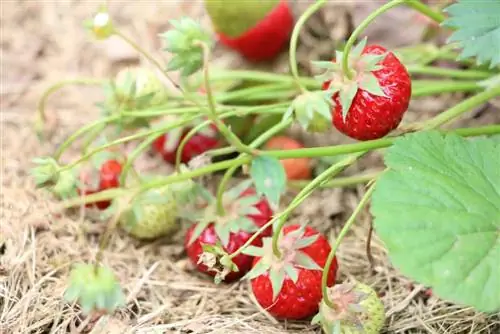
Ranging strawberries, regardless of the variety, are not a bit more difficult to care for than normal strawberries. Of these (at least the genetically complete old varieties), strawberry connoisseurs claim that they are all very easy to care for - at least among the normally growing, runner-forming old varieties - good soil, a few organic nutrients, water if necessary, and the strawberry grows.
The everbearing varieties are even easier to care for because they are all incredibly vigorous. Beginners can find out about details of the planting process and care in the articles “Balcony strawberries”, “Sowing and growing strawberries”, “The best substrate for strawberries”, otherwise the following special features apply to hanging strawberries:
Since strawberries are not climbing plants, they do not develop tendrils, no matter how stubborn their runners are. Your strawberry plant will therefore not wind its way around any trellises on its own (even if the sales description says so). If you want trailing strawberries to grow over the edge of the pot in a certain direction (preferably towards the sun, for sweetness and aroma), you have to force them to do so; Install pioneering rods, ropes, cords and tie the runners delicately to them. You can now consider whether you can turn the trailing strawberry into a climbing strawberry by tying a few runners to a climbing aid at the top.
In contrast to single-bearing varieties, which are only fertilized again in the autumn after the harvest, ever-bearing varieties are fertilized from emergence in spring. Depending on the growth rate, every two or even once a week. You can find out more about the recommended fertilizer in the article “Fertilize strawberries correctly”.
Tip:
If you remove all flowers that appear before early June, the plant will produce more runners and bear more fruit.
Wintering
For commercial varieties it only makes sense for 2 to 3 years because the plants are then exhausted. Some old cultivars are said to produce good harvests for up to a decade. Whether you remove harvested runners after the harvest or only in spring is a matter of taste, see also the paragraph “Overwintering balcony strawberries”.
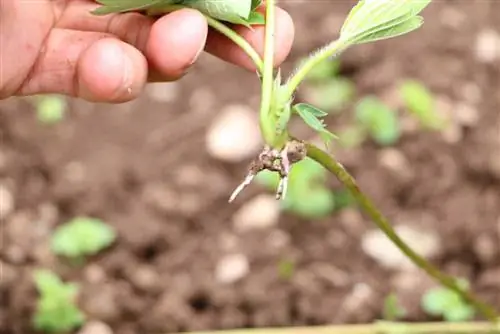
The plants are usually uncritically hardy (if an exotic variety is sensitive to this, you will be informed of this in the description). However, strawberries in hanging baskets do not have the volume of soil around them as strawberries in the garden and need some protection in winter. You can use the pots on the balcony, for example. B. wrap it with bubble wrap or other insulating material and hang it close to the house wall.
Tip:
Frost-free wintering in the winter garden (hallway), where towards the end of the life of the first strawberry plants you can also let runners root in the pot for the next season (water a little in winter too).

